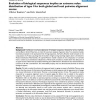467 search results - page 89 / 94 » A Method of Recognizing Entity and Relation |
ATAL
2010
Springer
13 years 12 months ago
2010
Springer
Multi-agent learning is a crucial method to control or find solutions for systems, in which more than one entity needs to be adaptive. In today's interconnected world, such s...
BMCBI
2010
13 years 11 months ago
2010
Background: The construction of interaction networks between proteins is central to understanding the underlying biological processes. However, since many useful relations are exc...
BMCBI
2010
13 years 11 months ago
2010
Background: Biological networks offer us a new way to investigate the interactions among different components and address the biological system as a whole. In this paper, a revers...
BMCBI
2008
13 years 11 months ago
2008
Background: Confidence in pairwise alignments of biological sequences, obtained by various methods such as Blast or Smith-Waterman, is critical for automatic analyses of genomic d...
IJRR
2006
13 years 10 months ago
2006
Current technological developments and application-driven demands are bringing us closer to the realization of autonomous multirobot systems performing increasingly complex missio...

